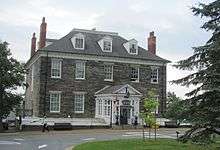Edward Augustus Inglefield
| Sir Edward Augustus Inglefield | |
|---|---|
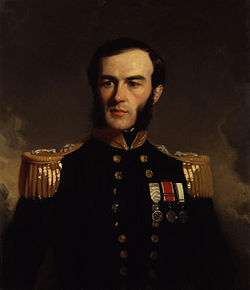 Portrait by Stephen Pearce, 1853. | |
| Born |
27 March 1820 Cheltenham, England |
| Died |
4 September 1894 (aged 74) South Kensington, London, England |
| Buried | Kensal Green Cemetery, London |
| Allegiance |
|
| Service/ |
|
| Years of service | 1832[1] – 1885 |
| Rank | Admiral |
| Awards |
Knight Commander of the Order of the Bath Fellow of the Royal Society Fellow of the Royal Geographical Society |
| Spouse(s) |
Eliza Fanny Johnston (m. 1857; her death 1890) |
| Relations |
Samuel Inglefield (father) Edward Fitzmaurice Inglefield (son) |
Admiral Sir Edward Augustus Inglefield KCB FRS FRGS DCL (27 March 1820 – 4 September 1894) was a Royal Naval officer who led one of the searches for the missing Arctic explorer John Franklin during the 1850s. In doing so, his expedition charted previously unexplored areas along the northern Canadian coastline, including Baffin Bay, Smith Sound and Lancaster Sound. He was also the inventor of the marine hydraulic steering gear and the anchor design that bears his name. The warship HMS Inglefield is named after him, as is the Inglefield Land region of Greenland and Inglefield Bay (Inglefieldbukta) on Spitsbergen, Norway.
Early life
Augustus Inglefield was born on 27 March 1820. He was the son of Rear Admiral Samuel Inglefield.[2]
Career
First voyage to the Arctic
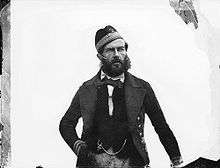
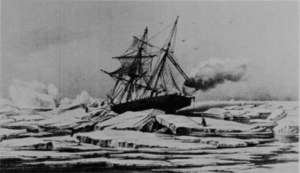
Inglefield set out from Britain on his search in July 1852, commanding Lady Franklin's private steamer Isabel, seven years after Franklin had left on his ill-fated search for the fabled Northwest Passage. Once Inglefield had reached the Arctic, a search and survey of Greenland's west coast was made; Ellesmere Island was resighted and named in honour of the president of the Royal Geographical Society; Smith Sound was penetrated further than any known records; Jones Sound was also searched; and a landing was made at Beechey Island in Lancaster Sound. No sign, however, of Franklin's expedition was found. Finally, before the onset of winter forced Inglefield to turn homewards, the expedition searched and charted much of Baffin Island's eastern coast.
Despite finding no traces of the Franklin expedition, Inglefield was fêted on his return for the surveying his expedition had achieved. The Royal Geographical Society awarded him its 1853 Patron's Medal "for his enterprising survey of the coasts of Baffin Bay, Smith Sound and Lancaster Sound."
Subsequent Arctic voyages
Inglefield made two further voyages to the Arctic in HMS Phoenix, to supply the search for the Franklin expedition overseen by Sir Edward Belcher. He returned from the first of these in 1853, bringing with him the first officer to have traversed the Northwest Passage, Samuel Gurney Cresswell of HMS Investigator. (The Investigator had also been sent to join the search for the Franklin expedition, but starting from the western side of northern Canada.)
Arriving back in the Arctic the following year, 1854, Inglefield found Belcher's ships abandoned, save one to which the crews had retreated. Most of these men returned with Inglefield to Britain.
Later life
Soon after his return from the Arctic, Inglefield was sent to join the Crimean War in the Black Sea as captain of HMS Firebrand, where he took part in the siege of Sevastopol. After the Crimean War, he captained a number of ships and continued to rise through the ranks. In 1869 he was made a rear admiral and three years later was appointed Admiral Superintendent of Malta Dockyard. Promotions to vice admiral and then admiral followed, between which he was knighted. In 1878 he was appointed Commander-in-Chief, North America and West Indies Station.[3]
Personal life
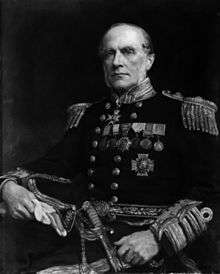
On 30 April 1857, Inglefield married Eliza Fanny Johnston (1836–1890), the daughter of Edward Johnston, Esq. of Allerton Hall, Liverpool. Together, they were the parents of four sons and one daughter:[4][2]
- Henry Beaufort Willmot Inglefield (1859–1926), who married Mary Lucia MacHugh, Lady Holker in 1894.[5][6] She was the widow of Sir John Holker (1828–1882).[7] After her death, he married Alexandra Amy Geraldine Butler (d. 1931), the widow of William George Gould (d. 1911)
- Edward Fitzmaurice Inglefield (1861–1945), a Royal Navy officer (eventually rear admiral), inventor of the Inglefield clip and Secretary to Lloyd's of London.
- Albany Otway Inglefield (1872–1873)
- Ernest Hallowell Inglefield (d. 1879)
- Sybill Inglefield (d. 1870)
Inglefield retired in 1885. Thereafter he devoted much of his time to painting and his watercolours of Arctic landscapes were exhibited at several art galleries in London. He died, aged seventy-four, in 1894, and is buried in Kensal Green Cemetery.
See also
- O'Byrne, William Richard (1849). "


Footnotes
- Notes
- ↑ "Arctic Profiles - Edward Augustus Inglefield" (PDF). Retrieved 2008-09-12.
- 1 2 "thePeerage.com". Retrieved 2008-09-12.
- ↑ William Loney RN
- ↑ Foster, Joseph (1881). The Baronetage and Knightage | Volume 2 of The Peerage, Baronetage, and Knightage of the British Empire for 1881. Nichols and Sons. Retrieved 15 May 2017.
- ↑ Royal Blue Book: Fashionable Directory and Parliamentary Guide. London: Kelly's Directories Limited. January 1899. Retrieved 15 May 2017.
- ↑ The Law Journal, Vol. 30. December 14, 1895. Retrieved 15 May 2017.
- ↑ Dod, Charles Roger; Dod, Robert Phipps (1904). Dod's Peerage, Baronetage and Knightage of Great Britain and Ireland, Including All the Titled Classes. London: Sampson Low, Marston & Company. Retrieved 15 May 2017.
- Sources
- Edward Augustus Inglefield, A summer search for Sir John Franklin; with a peep into the polar basin, Thomas-Harrison, London: 1853.
- E. C. Coleman, The Royal Navy in Polar Exploration from Franklin to Scott, Tempus Publishing: 2006.
External links
| Wikimedia Commons has media related to Edward Augustus Inglefield. |
- Works by or about Edward Augustus Inglefield at Internet Archive
- Three portraits of Sir Edward Augustus Inglefield at the National Portrait Gallery in London.
| Military offices | ||
|---|---|---|
| Preceded by Astley Key |
Admiral Superintendent, Malta Dockyard 1872–1876 |
Succeeded by Edward Rice |
| Preceded by Sir Astley Key |
Commander-in-Chief, North America and West Indies Station 1878–1879 |
Succeeded by Sir Francis McClintock |
